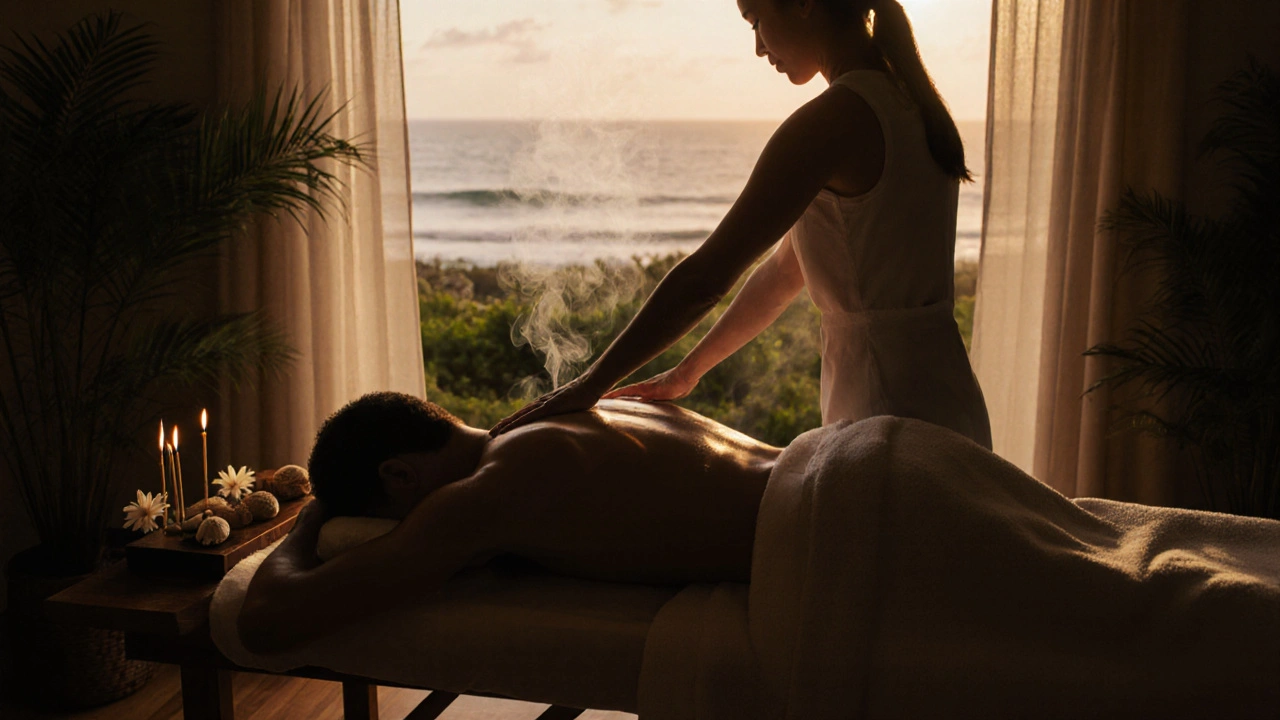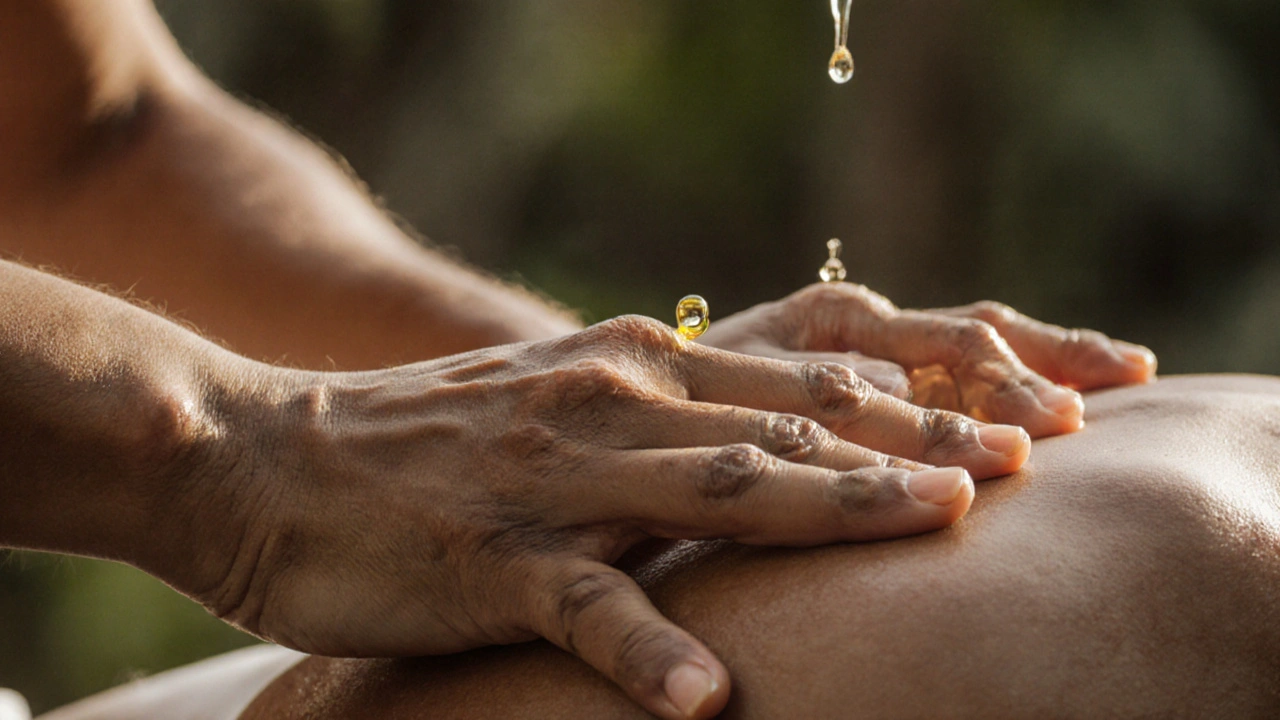Embrace Wellness with Lomi Lomi Massage: A Deep Dive into Hawaiian Healing
 Nov, 18 2025
Nov, 18 2025
When you think of massage, you might picture deep tissue knots being worked out or a quick relaxation session after a long week. But lomi lomi massage isn’t just about muscle relief-it’s a full-body, soul-level reset rooted in centuries of Hawaiian tradition. If you’ve ever walked away from a session feeling lighter, calmer, and strangely connected to something bigger than yourself, you’ve felt the ripple of lomi lomi’s true power.
What Makes Lomi Lomi Different?
Lomi lomi isn’t a technique you learn from a manual. It’s a practice passed down through generations of Hawaiian healers, called kahuna. The word itself means "to knead" or "to rub gently," but that’s just the surface. At its core, lomi lomi is about flow-flow of energy, flow of breath, flow of intention. Unlike Swedish or Thai massage, where pressure is applied in set patterns, lomi lomi moves like ocean waves. Therapists use their forearms, hands, and sometimes even elbows in long, continuous strokes that glide over the body without stopping.
There’s no rigid sequence. No checklist of muscles to target. Instead, the therapist tunes into your body’s rhythm-your breath, your tension, even your silence. If you’re holding your shoulder tight, they’ll feel it before you say a word. If your mind is racing, their touch becomes a gentle anchor. This isn’t just bodywork; it’s a conversation between healer and recipient.
The Spirit Behind the Touch
Many people assume lomi lomi is just a relaxing massage with a Hawaiian name. But it’s deeply spiritual. Traditional practitioners begin each session with a prayer, called a pule, to honor the ancestors, the land, and the spirit of healing. They don’t just work on your muscles-they work on your mana, your life force. The belief is that emotional pain, stress, and trauma get stored in the body like sediment. Lomi lomi doesn’t push it out-it helps it dissolve.
One client I spoke with in Sydney, a teacher who’d been dealing with burnout for years, said after her first session: "It felt like I was finally allowed to let go. Not because I was told to, but because my body remembered how." That’s the magic. It doesn’t force change. It invites it.
How It Feels: Beyond Relaxation
During a lomi lomi session, you might feel warmth spreading through your legs like sunlight. Your arms might feel heavy, then suddenly light. Some people cry. Others laugh. Some fall into a deep, dreamlike state. All of it is normal. The massage doesn’t aim to make you feel good-it aims to make you feel whole.
Unlike deep tissue massage, which can leave you sore, lomi lomi leaves you soft. Not limp-soft. Like your bones have been gently loosened from their stress. Your skin feels alive. Your breath deepens on its own. You might notice your jaw unclenches hours later. Your shoulders stay lower for days. That’s not coincidence. It’s the body remembering how to relax without being told.

What to Expect in a Session
A typical lomi lomi session lasts 60 to 90 minutes. You’ll lie on a warm table, covered only with a towel. The therapist uses organic coconut or macadamia oil-never synthetic lotions. The room is quiet, often with soft chants or the sound of ocean waves playing faintly in the background. No music with beats. No talking unless you initiate it.
The therapist works with both hands simultaneously, using fluid, rhythmic motions. One arm might stroke your back while the other glides down your leg. There’s no pressure checklist. No "this area needs more work." The touch is intuitive, continuous, and deeply nurturing. You’re not a client-you’re a person being held.
Afterward, you’ll likely feel a sense of calm so deep it surprises you. Some people nap for an hour. Others sit quietly with tea, staring out the window. Don’t rush. Let the stillness settle.
Who Benefits Most?
Lomi lomi isn’t just for people with back pain or stiff necks. It’s for anyone carrying invisible weight. If you’ve been through grief, trauma, chronic stress, or even just the slow erosion of daily life-this is for you.
It’s especially powerful for:
- People who feel emotionally numb or disconnected
- Those recovering from burnout or emotional exhaustion
- Individuals who respond better to gentle, intuitive care than forceful techniques
- Anyone seeking a deeper connection to their body beyond fitness or aesthetics
It’s not a quick fix. But if you’ve tried everything else and still feel like something’s missing-lomi lomi might be the missing piece.

How to Find a Genuine Practitioner
Not every "Hawaiian massage" is lomi lomi. Many spas use the name for marketing without understanding the tradition. To find a true practitioner, ask these questions:
- Did you learn from a Hawaiian kahuna or lineage holder?
- Do you begin sessions with a prayer or intention-setting?
- Do you use traditional oils and avoid synthetic products?
- Is your training rooted in cultural respect, not just technique?
In Sydney, look for therapists who mention their training with Hawaiian healers like Dr. Mary Kawena Pukui or the Kahuna Bodywork Institute. Avoid places that offer "lomi lomi express" 30-minute sessions. That’s not lomi lomi. That’s a massage with a Hawaiian soundtrack.
What to Do After Your Session
Don’t jump into your car and head to the office. Give yourself space. Drink plenty of water-your body is releasing stored tension. Avoid caffeine and heavy meals for a few hours. Sit outside if you can. Listen to birds. Feel the wind. The effects of lomi lomi don’t stop when the massage ends-they unfold over the next 24 to 72 hours.
Some people start journaling after their first session. Others find themselves dreaming more vividly. A few even report feeling more connected to loved ones. These aren’t side effects. They’re signs your system is recalibrating.
Why It Still Matters Today
In a world that rewards speed, productivity, and control, lomi lomi offers something radical: surrender. It doesn’t ask you to fix yourself. It doesn’t demand results. It simply says: Here. Be. Let go.
That’s not just healing. That’s resistance. Resistance to the idea that you have to earn peace. That you need to earn the right to rest. Lomi lomi says: You already have it. You just forgot how to feel it.
If you’ve been searching for wellness that doesn’t come in a pill, a subscription box, or a 10-minute app-this is it. A touch that remembers what your soul forgot. A rhythm older than stress. A way back to yourself.
Is lomi lomi massage painful?
No, lomi lomi is not meant to be painful. It uses long, flowing strokes with moderate pressure, often described as deeply soothing rather than intense. Unlike deep tissue massage, which targets specific knots, lomi lomi works with the body’s natural rhythms. If you feel discomfort, it’s a sign to communicate with your therapist-your comfort is part of the healing.
How often should I get a lomi lomi massage?
There’s no set rule, but many people find benefit in monthly sessions to maintain emotional and physical balance. If you’re going through a stressful time-grief, major life changes, chronic fatigue-weekly sessions for 4 to 6 weeks can help reset your nervous system. After that, monthly or bi-monthly maintenance works well. Listen to your body; it will tell you when it’s time to return.
Can lomi lomi help with anxiety or depression?
Many people report reduced anxiety and improved mood after regular lomi lomi sessions. The massage activates the parasympathetic nervous system, helping lower cortisol and increase serotonin. While it’s not a replacement for therapy or medication, it’s a powerful complementary tool for emotional regulation. People with depression often describe feeling "seen" and held during the session-a rare experience in daily life.
Do I need to believe in spirituality for lomi lomi to work?
No. While lomi lomi has spiritual roots, you don’t need to believe in energy fields or ancestral spirits for it to help. The physical effects-reduced muscle tension, deeper breathing, lowered heart rate-are real and measurable. Many skeptics report feeling calmer and more relaxed after their first session, even if they didn’t understand the cultural context. The touch speaks for itself.
What should I wear during a lomi lomi massage?
Most practitioners work with you draped in a towel, so you’ll be unclothed but covered at all times. You can wear underwear if you’re more comfortable, but the therapist needs access to your back, shoulders, and legs for the full flow of strokes. The room will be warm and private. Your modesty is respected throughout.
